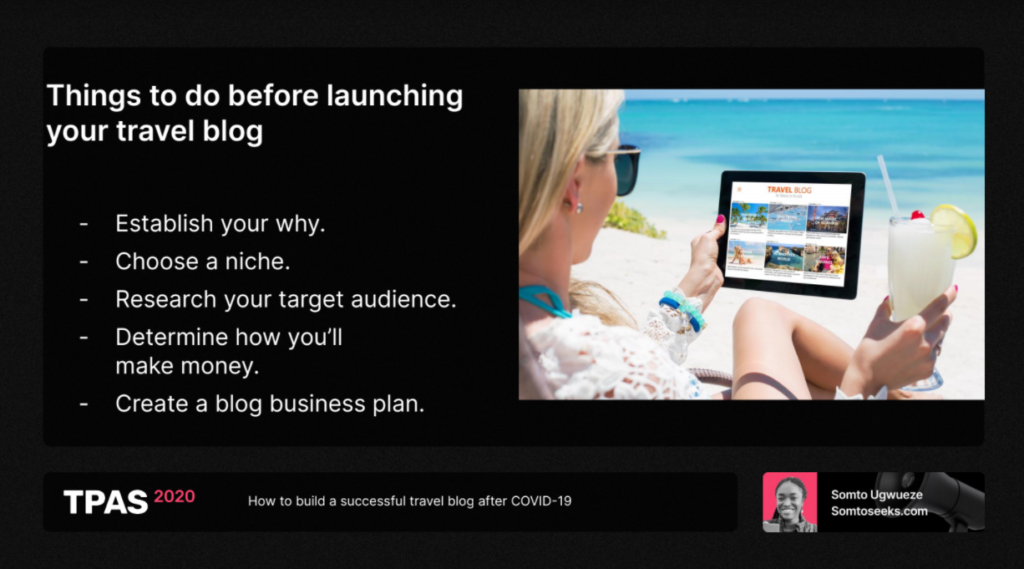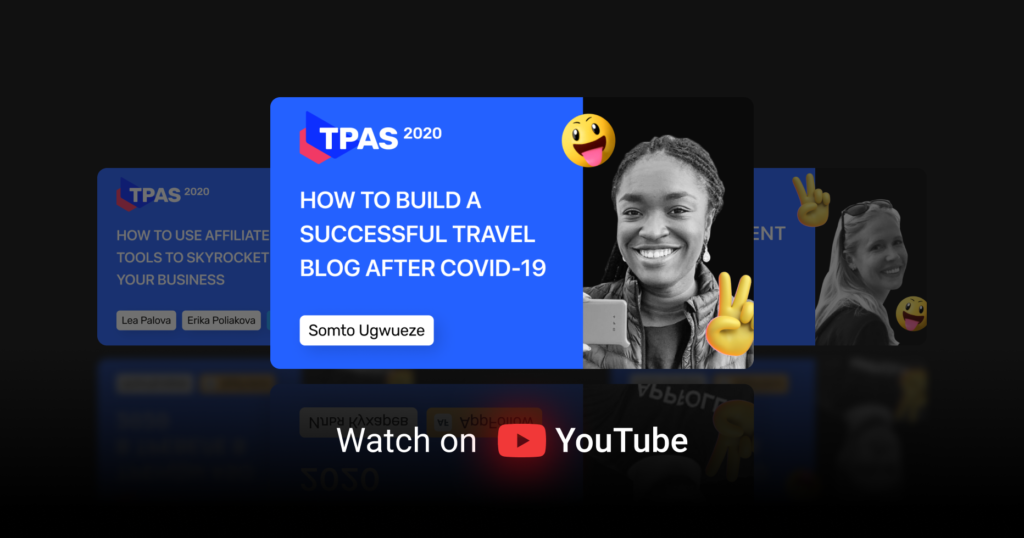Somto Ugwueze is the voice behind Somtoseeks.com and has over three years of blogging experience. She’s been featured in publications such as the Matador Network, Huffington Post, Travel Noire, Nomadic Matt, and a few others.

Travel Blogging: Post-COVID-19 Predictions
Here are the predictions that Somto shares [1:19] regarding the future of the travel industry:
- The travel blogging niche will become smaller, as numerous companies made adjustments due to the pandemic, which led to a decline in traffic for many bloggers.
- Marketers without significant income will have to leave the niche and explore other career opportunities in sectors that haven’t been affected by the crisis.
- Meanwhile, established bloggers with a decade of experience or more will bounce back faster.
- Newer bloggers will niche down to stand out from their competition by covering narrower topics or addressing smaller target audiences.
- Local travel will continue increasing in popularity due to restrictions related to COVID-19. People will explore places within their own countries, go on road trips, explore national parks, and so on.
Things to Do Before You Start a Travel Blog
When thinking about how to start a travel blog and earn money in the travel niche, be sure to look through the following checklist that Somto shared at the webinar and find your answers.

Establish Your Why
How to start a successful travel blog? First and foremost, you need to have a compelling reason that will drive you for years to come. Travel blogging might seem glamorous on social media, but there’s a lot of hard work behind the scenes, including finding new content marketing ideas, writing, planning, etc. So, you need to establish your why.
First, think about your blog’s mission. What is the purpose behind it? What people do you strive to help? What market gap can your blog fill out?
Second, reflect on your personal reasons. Why is it important for you to start blogging? For example, Somto shares that she launched her travel blog to help out solo black female travelers, as there wasn’t much specific advice on the internet for this group, and to get her voice out there and share her perspective.
Choose a Niche
The next step is selecting a niche for your blog. It’s more efficient to select a narrower topic rather than write about everything. In the case with Somto [6:27], she chose solo female travel and black travel as her sub-niches.
Choosing a specific topic is crucial, as, to succeed, you need to help a specific audience solve a specific issue.
Here are five questions to ask yourself when choosing a niche:
- What am I knowledgeable about? What topics do I constantly research and can talk about endlessly?
- Is there an audience for this niche? Are there people who want to learn about my topic?
- How can I make money in this niche? Will the audience be willing to pay for a solution to their problems? Or are they just looking for free advice?
- How much competition is in the industry? If there is competition, that’s a good thing, as people are actually making money in the niche and you can too. However, too much competition might be hard to tackle when the niche is owned by a couple of big brands that are difficult to compete with.
- Can I write about this niche for the next two years? Will I have the same excitement after writing 10, 30, or 50 posts? Two years is usually enough to rank on Google and social media.
Research Your Travel Audience
There are numerous tools that can automate your audience research and help you discover relevant content ideas for your website.
Google Trends
This free tool helps you identify popular keywords, check their performance over time, and choose a trending niche. Somto shares an example of analyzing keywords, such as “africa travel” and “asia travel”.
For the “africa travel” keyword, you can see that it was used pretty steadily from 2015 till April 2020, then briefly shot up. This can be explained by the fact that, during the pandemic, people started looking for alternative destinations and, as Africa hasn’t been hit as hard by COVID-19 as other countries, the keyword is still trending upward. This is a good sign for those planning to write about trips to Africa, because people want to explore the destination.
In case of “asia travel”, the keyword’s popularity was more or less stable from 2015 to 2019. In early 2020, the term experienced an increase in searches. However, the reason is different from the increase seen in the previous keyword, as Asia was strongly affected by the pandemic and people were likely to look for travel advisories and examine the situation. This keyword is trending downward, so it doesn’t make much sense to launch a travel blog about Asia now because of COVID-19.
Buzzsumo
BuzzSumo helps you find the most shared keywords on social media and compare it to another keyword. Somto shares an example [14:52] of researching the “small group travel” and “couples travel” keywords and comparing their shares on social media to understand how to choose a trending topic.
Pinterest is a visual search engine with over 400 million monthly users that helps you discover new ideas and is perfect for travel blogging, as travel is one of the most searched topics on Pinterest. For each search, you’ll also see color-coded boxes with related popular topics that can help you understand what people are looking for and craft content that will be popular.
Blog Income Reports
Blog income reports are another great tool for researching the market. Plenty of bloggers share their income reports on the internet, which can help you develop a marketing plan for your own blog.
First, explore monetization strategies, such as advertising, affiliate marketing, sponsored posts, etc. Then, check which products are promoted and earn commissions. If you happen to use one of these products, you can write reviews about it based on personal experience, share affiliate links, and generate revenue.
Creating a Blog Business Plan
While some people don’t take writing business plans seriously, it is beneficial in many ways. A detailed business plan helps clarify your blog’s mission, strategies, goals, target audiences, traffic sources, etc. By putting all this in writing, you’re likely to take your goals more seriously. A business plan also helps you treat your blog like a business and think long-term.
How to Create Epic Content
Consistent, high-quality content is what drives visitors to your site and converts them into subscribers, customers, etc. When thinking about how to start a blog that generates good traffic, make sure to implement the following three main components of epic content:
- Address one topic in depth. For example, create an exhaustive guide for one specific place or travel topic.
- Offer a new perspective or address something that other authors disregard.
- Optimize content for keywords with the focus on your readers before search engines. It’s crucial to satisfy user intent because your readers are those whom you want to commit the desired action on your site.
The Process of Writing Epic Content
Somto shares [24:26] a three-step process for creating epic travel blog content.
- Run keyword research. A common mistake is to brainstorm ideas that you think your readers might like or be interested in and then checking the competitiveness of random keywords. Instead of guesswork, consider running competitor research. If blogs are ranking for particular keywords, you can follow suit.
- Read through the top 10 to 20 posts of the search results. Then, search for gaps to fill in or explore an existing topic from a new perspective. For instance, if you are writing travel guides, try to describe different neighbourhoods, sights, and landmarks.
- Write long, in-depth content. A study by Backlinko, a popular marketing and SEO blog, found that the average length of a top ten post on Google is 1,500 words. Long reads imply value and are favored by both search engines and readers. Naturally, a 2,000-word post covers more angles than a 200-word post. Somto recommends aiming for 1,200-5,000 words, depending on your niche and topic.
Keyword Research Tools
These tools help you plan your blog content, such as types of posts, ideal post length, keywords, etc. Below, you’ll find a few platforms that Somto recommends for running proper keyword research.
Keysearch
Keysearch is a great tool for beginners with a price starting from $17 per month. It’s user-friendly and not as complex as other tools. Keysearch helps you check keyword competitiveness, domain authority for the top ten posts, which is basically the number of backlinks to these sites, as well as other relevant information.
Semrush
SEMrush is a more advanced and expensive tool, starting from $99.95 per month. It has a wealth of information that can make a big difference for SEO. For instance, SEMrush identifies posts ranking for your keyword, their length, and more, so you can write a longer post and fight for your place on Google.
Ahrefs
Ahrefs is another sophisticated platform that is perfect for link building and growing domain authority, as it provides you with an overview of your competitors’ backlinks. Ahrefs will be more useful for experienced bloggers, as building a link profile is only beneficial when one has enough quality content. Aspiring writers should focus on writing for the first three to six months and then start building links.
Examples of Epic Content
To provide some examples, Somto shares [34:51] a few high-performing posts of her own:
- A 4,000-word article about racism in Spain, based on Somto’s personal experience as an expat. It has ranked number one on Google for the keyword “racism in Spain” for over two years.
- Her 6,000-word post “101 Free or Cheap Things to Do in Madrid” covers virtually every activity that one can hope to find in Madrid: restaurants, museums, day trips, etc. The post ranks number one on Google for the keyword “cheap things to do in Madrid”.
- In her 1,300-word post “Barcelona Walking Tour with Map for First Time Visitors”, Somto takes a different approach, and instead of writing how awesome Barcelona is, she calls it overrated, which provoked a lot of discussion and generated many shares on social media (over 70,000 on Pinterest).
Apart from her own posts, Somto also shares some outstanding examples from other travel blogs.
- The post “13 Best Islands in Croatia To Visit” from the “Hand Luggage Only” travel blog is around 2,000 words long, goes in-depth about the topic, and stands out thanks to its amazing imagery.
- While “25 Reasons Why Women Should Never Travel Solo” from Be My Travel Muse is only 1,000 words, the post was highly successful and generated thousands of shares on social media. Contrary to the title, the author challenges negative misconceptions about solo female travel. It is a great example of how to use controversy in your writing.
Underpinning all this, it’s important to focus on writing valuable posts, which go in-depth into the topic and are a kind of one-stop resources for readers. Providing appealing imagery is just as important, especially for travel blogs, as people want to see where you’re going. Last, but not least, controversy is a great technique to stir up conversation and get more shares.
Rookie Mistakes to Avoid
When thinking how to set up a travel blog, be sure to avoid the following mistakes that Somto finds [43:26] very common among aspiring bloggers.
- Writing for yourself instead of your audience: To find content ideas for blogs, some webmasters start simply sharing their own experience and opinions. But readers are looking for hands-on tips that’ll help them plan their own trips. So, your content marketing should be geared towards improving users’ travel experience rather than writing a diary style blog.
- Ignoring SEO: Search engine optimization is what drives traffic to your site in the long term and rewards you for years to come. Start with on-page SEO (running keyword research and optimizing your blog for keywords) and then move on to off-page SEO (building backlinks and increasing domain authority).
- Quantity over quality: Don’t write short posts for the sake of publishing and try to create fewer but longer posts that elaborate on the topic in detail. Think about user intent, add relevant keywords, etc.
- Leveraging all social media at once: When thinking about how to make a travel blog popular on social media, many aspiring bloggers want to achieve maximum exposure immediately. However, that’s a surefire way to spread oneself too thin. Instead, start with one platform, build it up, and then take on the next one.
- Trying to do everything by yourself: Travel blogging does not equal isolation. By networking with other marketers, you can discover new opportunities. For instance, start a travel blog promotion by running a joint giveaway or webinar, exchanging guest posts, etc.
Presentation
You can download the presentation from the webinar at this link.

